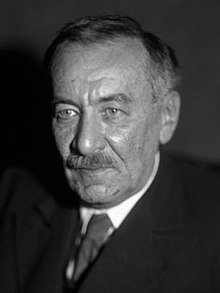Leonid Mandelstam
Leonid Mandelstam | |
|---|---|
 | |
| Born | Leonid Isaakovich Mandelstam 4 May 1879 |
| Died | 27 November 1944(aged 65) |
| Scientific career | |
| Doctoral advisor | Karl Ferdinand Braun |
| Doctoral students | Aleksandr Andronov, Mikhail Leontovich, Igor Tamm |
Leonid Isaakovich MandelstamorMandelshtam(Russian:Леонид Исаакович Мандельштам;4 May 1879 – 27 November 1944) was a Soviet and Russian physicist.
Life
[edit]Leonid Mandelstam was born inMogilev,Russian Empire(nowBelarus) into a Jewish family. He studied at theNovorossiya UniversityinOdesa,but was expelled in 1899 due to political activities, and continued his studies at theUniversity of Strasbourg.He remained in Strasbourg until 1914, and returned with the beginning ofWorld War I.He was awarded theStalin Prizein 1942. He died inMoscow,aged 65.[1]
Scientific achievements
[edit]The main emphasis of his work was broadly considered theory ofoscillations,which includedopticsandquantum mechanics.He was a co-discoverer of inelasticcombinationalscatteringof lightused now inRaman spectroscopy(see below). This paradigm-altering discovery (together withGrigory Landsberg) had occurred at theMoscow State Universityjust one week earlier than a parallel discovery of the same phenomena byC. V. RamanandK. S. Krishnan.In Russian literature it is called"combinational scattering of light"(from combination of frequencies of photons and molecular vibrations) but in English it is named after Raman.
Discovery of the combinational scattering of light
[edit]In 1918, Mandelstam theoretically predicted thefine structuresplitting inRayleigh scatteringdue to light scattering on thermal acoustic waves. Beginning from 1926, Mandelstam and Landsberg initiated experimental studies on vibrational scattering of light incrystalsat the Moscow State University. As a result of this research, Landsberg and Mandelstam discovered the effect of the combinational scattering of light on 21 February 1928. They presented this fundamental discovery for the first time at a colloquium on 27 April 1928. They published brief reports about this discovery (experimental results with some attempt at a theoretical explanation) in Russian[2]and in German[3]and then published a comprehensive paper inZeitschrift für Physik.[4]
In the same year, two Indian scientists C. V. Raman and K. S. Krishnan also observed the inelastic scattering of light. Raman stated that "The line spectrum of the new radiation was first seen on 28 February 1928".[5]Thus, combinational scattering of light was observed by Mandelstam and Landsberg a week earlier than by Raman and Krishnan. However, according to the Physics Nobel Committee, Mandelstam and Landsberg were unable to provide an independent, complete interpretation for the discovery, as they only later cited Raman's article. Also, their observations were limited to crystals, whereas Raman and Krishnan showed the effect in solids, liquids, and vapors, thus proving the universal nature of the effect. Raman's method was further applied with great success in different fields of molecular physics, for example in the composition analysis of liquids, gases, and solids, and provided significant insight on nuclear spins.[6][7]Hence, the light-scattering phenomenon became known asRaman scatteringor the Raman effect.
Mandelstam's lectures in optics dated by 1944 can be considered as the formal beginning of the second stage of the DNG-metamaterialstheory.[8]
Scientific school and legacy
[edit]Mandelstam founded one of the two major schools of theoretical physics in theSoviet Union(another being due toLev Landau). In particular, he was mentor toIgor Tamm,aNobel Prize in Physicslaureate who in turn was a mentor toVitaly Ginzburgwho also received a Nobel Prize in Physics andAndrei Sakharov,the "father of Soviet hydrogen bomb" and aNobel Peace Prizelaureate.
A crater on the far side of the Moonis named after Mandelstam.
See also
[edit]Selected publications
[edit]- L. I. Mandelstam,I. E. Tamm"The uncertainty relation between energy and time in nonrelativistic quantum mechanics",Izv. Akad. Nauk SSSR (ser. fiz.)9,122–128 (1945). English translation: J. Phys. (USSR)9,249–254 (1945).
References
[edit]- ^E.L. Feinberg (2002). "The forefather".Physics-Uspekhi.45(1): 81.Bibcode:2002PhyU...45...81F.doi:10.1070/PU2002v045n01ABEH001126.S2CID250780246.
- ^G.S. Landsherg, L.I. Mandelstam, "New phenomenon in scattering of light (preliminary report)",Journal of the Russian Physico-Chemical Society, Physics Section60,335 (1928).
- ^G. Landsberg, L.Mandelstam (1928). "Eine neue Erscheinung bei der Lichtzerstreuung in Krystallen".Die Naturwissenschaften.16(28): 557–558.Bibcode:1928NW.....16..557..doi:10.1007/BF01506807.S2CID22492141.
- ^G.S. Landsherg and L.I. Mandelstam (1928). "Über die Lichtzerstreuung in Kristallen".Zeitschrift für Physik.50(11–12): 769.Bibcode:1928ZPhy...50..769L.doi:10.1007/BF01339412.S2CID119357805.
- ^C.V. Raman (1928)."A new radiation"(PDF).Ind. J. Phys.2:387.
- ^"C. V. Raman: The Raman Effect".American Chemical Society.Archived fromthe originalon 12 January 2013.Retrieved6 June2012.
- ^Singh, Rajinder; Riess, Falk (2001). "The Nobel Prize for Physics in 1930 – A close decision?".Notes and Records of the Royal Society of London.55(2): 267–283.doi:10.1098/rsnr.2001.0143.S2CID121955580.
- ^Slyusar V.I. Metamaterials on antenna solutions.// 7th International Conference on Antenna Theory and Techniques ICATT’09, Lviv, Ukraine, October 6–9, 2009. - Pp. 20.[1]
External links
[edit]- 1879 births
- 1944 deaths
- People from Mogilev
- Academic staff of the University of Strasbourg
- Full Members of the USSR Academy of Sciences
- Moscow State University alumni
- Academic staff of Moscow State University
- University of Strasbourg alumni
- Recipients of the Order of Lenin
- Recipients of the Order of the Red Banner of Labour
- Recipients of the Stalin Prize
- Recipients of the Lenin Prize
- Jews from the Russian Empire
- Optical physicists
- Belarusian Jews
- Belarusian physicists
- Jewish Russian physicists
- Russian physicists
- Soviet Jews
- Soviet physicists
- Burials at Novodevichy Cemetery
- Russian scientists
